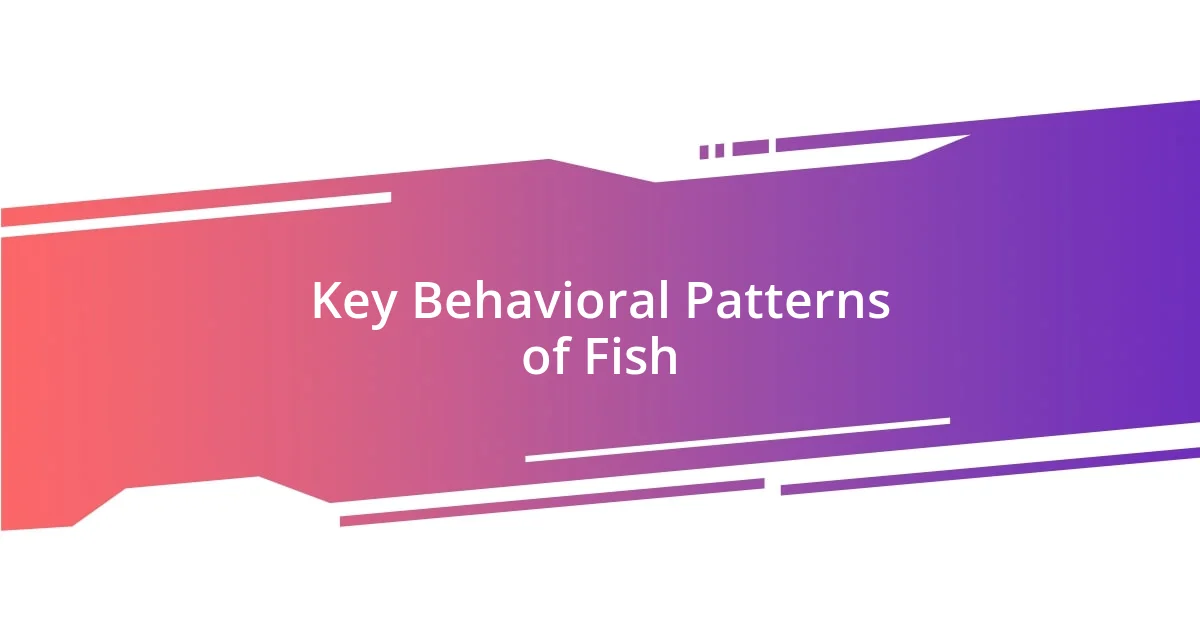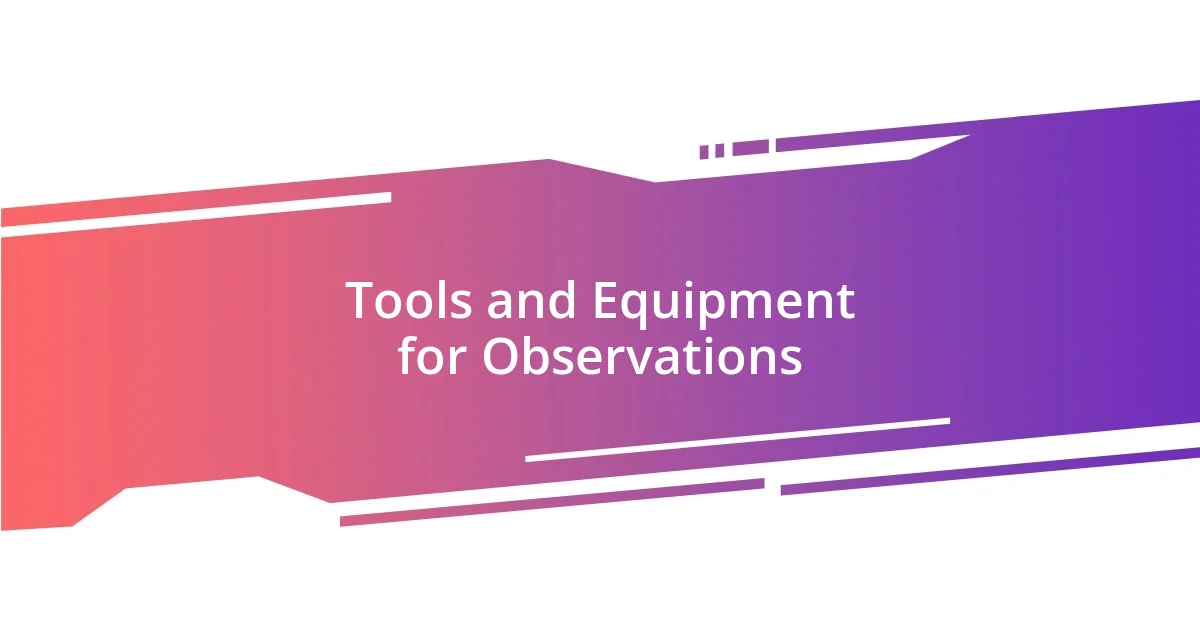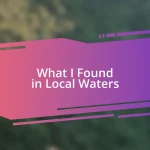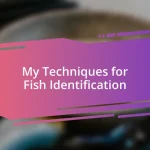Key takeaways:
- Effective fish observation requires patience, stillness, and natural light to notice unique behaviors and details.
- Documenting observations in detail, including sketches and notes, enhances personal connections and understanding of fish behavior.
- Analyzing behavior data and habitat interactions can inform conservation efforts, highlighting the importance of preserving ecosystems for fish populations.

Techniques for Effective Fish Observation
When I first started observing fish, I quickly realized the importance of being patient and still. The water can be a serene classroom, but if you’re moving around too much, fish will disappear in an instant. Have you ever felt that mix of excitement and frustration while waiting? I remember feeling this rush of anticipation, watching a group of colorful tetras dart around, only to have them vanish the moment I shifted my position.
Another technique I found invaluable is the use of natural light. I can’t stress enough how lighting can enhance your observations. Observing fish during different times of day revealed unique behaviors—morning light brings out vibrant colors, while dusk brings a calmer, more peaceful energy. It makes me wonder: what secrets lie in those subtle variations of their daily rhythms? I often found myself enchanted by how shadows could create a dramatic backdrop for their movements, illuminating aspects of their behavior I had never noticed before.
Finally, keeping a journal of your observations adds a personal touch to the experience. After each session, writing down what I witnessed allowed me to reflect on my feelings and insights, building a deeper connection to the aquatic world. Have you ever looked back at your notes and felt a sense of nostalgia? I recall flipping through my early entries and smiling at the raw enthusiasm I felt, which is a beautiful reminder of how observing fish can foster not just knowledge but a real love for nature.

Key Behavioral Patterns of Fish
Fish exhibit fascinating behavioral patterns that can often be observed in their daily activities. One key behavior is schooling, where fish like sardines or mackerels swim together in organized groups, offering protection from predators. I remember observing a school of guppies in my aquarium; their synchronized movements were mesmerizing and made me appreciate how safety in numbers can have such a profound effect on their overall wellbeing.
Another notable behavior found in fish is territoriality, particularly among species like cichlids. Watching a male cichlid defend its territory against intruders was both alarming and awe-inspiring. I felt a rush of adrenaline as I witnessed this colorful warrior, fins flared and body poised, challenging any fish daring to encroach. This dynamic of aggression and defense brought about an interesting realization: there’s a fine balance between survival instincts and community dynamics among fish that mirrors our human interactions.
Lastly, feeding habits reveal much about fish behaviors. I often notice how some species are aggressive feeders while others are more subdued, picking at food delicately. One evening, I experimented by scattering different types of food in my tank, and it was amazing to see how my betta completely dominated the surface, showcasing its boldness, while my shy axolotl lingered on the bottom, taking its time. This range in feeding styles not only illustrates their individual personalities but also made me reflect on the uniqueness we all possess in our approaches to nourishment and survival.
| Behavior | Description |
|---|---|
| Schooling | Many fish swim together in coordinated groups for safety and social interaction. |
| Territoriality | Fish like cichlids defend their space aggressively against perceived intruders. |
| Feeding Habits | Different species exhibit unique feeding styles, from aggressive to cautious approaches. |

Tools and Equipment for Observations
When it comes to observing fish closely, having the right tools and equipment can elevate your experience significantly. I remember the first few times I tried to spot my aquarium’s inhabitants without any gear, and it was almost comical. Not having a proper setup left me squinting and moving about like a child trying to catch fireflies. I quickly learned that a few essential items can transform your observations into a much more enjoyable and insightful endeavor.
Here are some tools and equipment that I’ve found invaluable for my fish-watching experiences:
- Submersible Camera: Capturing underwater footage helps me analyze behaviors over time and relive those magical moments.
- Waterproof Notebook: Keeping my notes handy for jotting down observations means I can easily record my thoughts, even in wet conditions.
- Polarizing Sunglasses: These not only reduce glare when observing fish from above but also enhance visibility and color saturation, making each viewing more vibrant.
- Dip Net: Thinly constructed but durable, this tool helps me gently catch a glimpse of shy fish without causing them stress.
- Fish Identification Guide: Having a reference at hand deepens my understanding and appreciation of various species, allowing me to recognize subtle differences.
As I experimented with different setups, I didn’t realize how much my understanding of the underwater world would expand. For example, using the submersible camera unveiled intricate details I had previously overlooked. Watching a shy fish reveal itself in the comfort of its favorite hiding spot was almost like observing magic. There’s something wonderfully intimate about it—like a secret shared only with you. It makes me feel connected not just to the fish but to the ecosystem itself, reminding me of the beautifully intricate relationship we all have within nature.

Documenting Your Fish Findings
Documenting your fish observations can be an incredibly rewarding experience. I often find myself jotting down notes right after I see something captivating. Just the other day, I noticed my neon tetras changing their behavior when I introduced a new decoration. Their initial shyness quickly shifted to playful darting around—the contrast was striking! Isn’t it fascinating how a simple change in environment can evoke such varied reactions?
I’ve learned the importance of detail in my documentation. For instance, I started recording specific times for feeding and behavioral changes, which helped me notice patterns I hadn’t seen before. One memorable instance was when I documented a spawning event among my zebra danios. I was amazed at how attentive the males were, chasing away larger fish to protect the eggs. Have you ever paused to really capture the little moments that reveal so much about your fish’s lives? It’s a whole new level of connection.
When I create my observation logs, I also include drawings and sketches. While I’m no artist, those little doodles make the experience even more personal. I once sketched my betta’s vibrant colors during feeding time, feeling his personality leap off the page. The act of capturing these moments not only enhances my understanding but also deepens my bond with the fish. What do you think—could putting pencil to paper enhance your connection with your aquatic friends?

Analyzing Fish Behavior Data
Analyzing fish behavior data has truly opened my eyes to the complexity of aquatic life. By tracking patterns like feeding times, water temperature, and tank changes, I can pinpoint how my fish react to different stimuli. Just last week, I realized that my guppies became more active shortly after I adjusted the water filtration system; their playful chases around the tank were remarkably different from their usual behavior. Isn’t it intriguing how even minor adjustments can lead to such infectious enthusiasm?
When examining the data, I often find surprises that challenge my expectations. I never anticipated that my once-timid corydoras would assert themselves when the light dimmed. My observations showed that they gathered near the substrate at twilight, digging up food with a newfound confidence. Reflecting on such moments makes me realize how our fish have unique personalities—reveling in the data elevates this understanding.
Moreover, I always encourage keeping a close eye on group dynamics. For instance, while analyzing the behavior of my schooling fish, I noticed that specific individuals tended to lead the swarms during feeding. It made me ponder: do these leadership roles correlate with their health and vitality? Such questions keep me engaged, and the thrill of unearthing insights from basic observation transforms every visit to my aquarium into an exciting investigation.

Applying Observations to Conservation Efforts
Understanding fish behavior has illuminated a path for impactful conservation efforts. During one of my weekend exploration trips, I observed how a local fish species thrived in sheltered areas among rocks and plants. This experience underscored how crucial habitats are for their survival. It made me realize that preserving these natural environments can significantly boost fish populations. Isn’t it amazing how our observations can directly influence conservation strategies?
As I examine the ways different species interact, I feel compelled to advocate for conservation measures that protect their social structures. For instance, watching my schooling fish navigate their environment, I noted how their cohesion depended on the stability of their habitat. This connection sparked a thought: if we can ensure these ecosystems remain intact, we’re not just saving fish but also fostering biodiversity. Could our observations lead to a broader understanding of ecological balance?
I’ve also participated in local conservation initiatives, armed with my observations to provide valuable insights. One time, I shared data on how pollution affected the feeding behavior of a local fish species. The team was fascinated and used this information to propose a cleanup effort in that area. It was a gratifying moment, knowing that my firsthand experiences could contribute to tangible change. Have you ever considered how your observations might offer a unique perspective in conservation dialogues?













